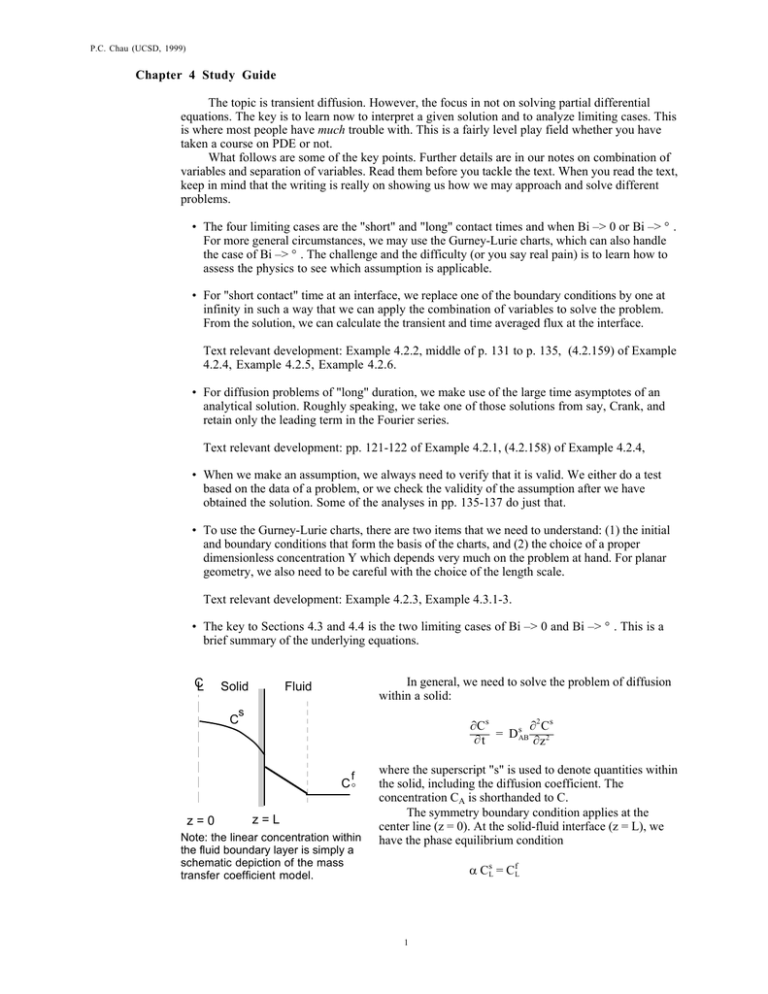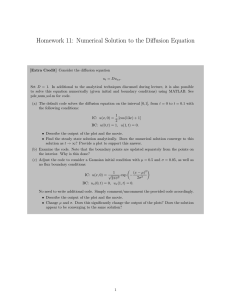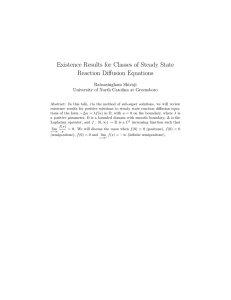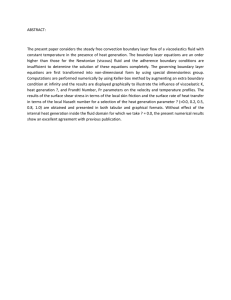Chapter 4 Study Guide The topic is transient diffusion. However, the
advertisement

P.C. Chau (UCSD, 1999) Chapter 4 Study Guide The topic is transient diffusion. However, the focus in not on solving partial differential equations. The key is to learn now to interpret a given solution and to analyze limiting cases. This is where most people have much trouble with. This is a fairly level play field whether you have taken a course on PDE or not. What follows are some of the key points. Further details are in our notes on combination of variables and separation of variables. Read them before you tackle the text. When you read the text, keep in mind that the writing is really on showing us how we may approach and solve different problems. • The four limiting cases are the "short" and "long" contact times and when Bi –> 0 or Bi –> ∞. For more general circumstances, we may use the Gurney-Lurie charts, which can also handle the case of Bi –> ∞. The challenge and the difficulty (or you say real pain) is to learn how to assess the physics to see which assumption is applicable. • For "short contact" time at an interface, we replace one of the boundary conditions by one at infinity in such a way that we can apply the combination of variables to solve the problem. From the solution, we can calculate the transient and time averaged flux at the interface. Text relevant development: Example 4.2.2, middle of p. 131 to p. 135, (4.2.159) of Example 4.2.4, Example 4.2.5, Example 4.2.6. • For diffusion problems of "long" duration, we make use of the large time asymptotes of an analytical solution. Roughly speaking, we take one of those solutions from say, Crank, and retain only the leading term in the Fourier series. Text relevant development: pp. 121-122 of Example 4.2.1, (4.2.158) of Example 4.2.4, • When we make an assumption, we always need to verify that it is valid. We either do a test based on the data of a problem, or we check the validity of the assumption after we have obtained the solution. Some of the analyses in pp. 135-137 do just that. • To use the Gurney-Lurie charts, there are two items that we need to understand: (1) the initial and boundary conditions that form the basis of the charts, and (2) the choice of a proper dimensionless concentration Y which depends very much on the problem at hand. For planar geometry, we also need to be careful with the choice of the length scale. Text relevant development: Example 4.2.3, Example 4.3.1-3. • The key to Sections 4.3 and 4.4 is the two limiting cases of Bi –> 0 and Bi –> ∞. This is a brief summary of the underlying equations. C L Solid In general, we need to solve the problem of diffusion within a solid: Fluid s C ∂Cs ∂2 Cs = D sAB 2 ∂t ∂z f C∞ z=0 z=L Note: the linear concentration within the fluid boundary layer is simply a schematic depiction of the mass transfer coefficient model. where the superscript "s" is used to denote quantities within the solid, including the diffusion coefficient. The concentration CA is shorthanded to C. The symmetry boundary condition applies at the center line (z = 0). At the solid-fluid interface (z = L), we have the phase equilibrium condition α CsL = CfL 1 P.C. Chau (UCSD, 1999) and the flux boundary condition – D sAB ∂Cs ∂z L = k c (CfL – Cf∞) where we use a mass transfer coefficient model to describe the external mass transport. As written, the unit of kc must be [cm/s in cgs units]. Since the solid diffusion problem solves for Cs, we substitute for the fluid concentration with the phase equilibrium condition, and the boundary condition becomes – D sAB ∂Cs ∂z L 1 Cf ) , where we can further define k = αk = αk c (CsL – α c ∞ If we define a dimensionless length x = z/L, we can put the condition in terms of the Biot number: ∂Cs – B1 i ∂x x=1 1 Cf , = CsL – α ∞ where Bi = αk c L D sAB The key is to note that the Biot number compares the rate of external convective mass transport to the rate of internal diffusion. When Bi becomes very large, the term on the LHS drops out, and there is no external fluid phase concentration difference. When Bi becomes very small, the internal concentration gradient becomes negligible.1 These two limiting cases are summarized in the schematic diagram below. CL CL Bi —> 0 Bi —> ∞ s s C C f C∞ f C∞ The two extreme cases of external mas transport. Left panel: When Bi approaches zero, the mass transport resistance resides in the fluid phase. The mass transport resistance in the solid is negligible, and the internal concentration is uniform. In other words, we do not need to solve the diffusion problem within the solid. Right panel: When Bi approaches infinity, the external mass transfer resistance is negligible. The concentration in the fluid at the surface is the same as in the bulk fluid. • When is the Biot small or large enough to apply the limiting approximations? The analysis in Section 4.4 is meant to establish that when Bi is less than approximately 0.2, the solution may approach that of Bi = 0. From the Gurney-Lurie charts, the solutions of cases when Bi is larger than 2 approach that of Bi = ∞. Thus in general, we may use the negligible internal resistance model when Bi ≤ O(0.1), and we may use the negligible internal resistance model when Bi ≥ O(10). 1 This is how we may argue that the internal diffusion resistance is negligible: If there is a finite mass transport rate, and if the quantities of the boundary condition remain "well behaved," then when Bi becomes very small, so must the gradient ∂Cs/∂x at x = 1. Note that the largest gradient is at the surface. Recall that the concentration gradient is zero by symmetry at the center. In addition, you may also note that as written, the concentration remains dimensional in the boundary condition. Proper choice of a dimensional concentration Y should turn this condition into the form used by the Gurney-Lurie charts. [More in our notes on separation of variables.] 2


